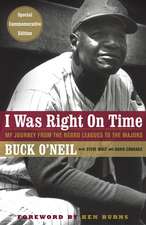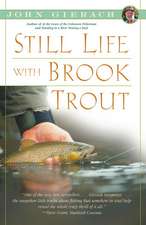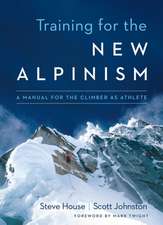Newton on the Tee: A Good Walk Through the Science of Golf: Gift for Golfers
Autor John Zumerchiken Limba Engleză Paperback – 16 iun 2008
At last, John Zumerchik, a passionate golfer and inquisitive science writer and editor, explores and explains the little details that make golf such a maddening, fascinating, and tantalizing pursuit. NEWTON ON THE TEE covers all of the game's hot topics.
With a firm grasp of both his subject and his seven-iron, Zumerchik takes the reader through all these topics and more, in an entertaining and enlightening work that crosses the questing appeal of Golf in the Kingdom with the coherence and clarity of popular science works from Cosmos to Chaos.
Preț: 96.27 lei
Nou
Puncte Express: 144
Preț estimativ în valută:
18.42€ • 20.09$ • 15.53£
18.42€ • 20.09$ • 15.53£
Carte disponibilă
Livrare economică 03-17 aprilie
Preluare comenzi: 021 569.72.76
Specificații
ISBN-13: 9781416541295
ISBN-10: 1416541292
Pagini: 256
Ilustrații: 6 b&w illustrations t-o
Dimensiuni: 140 x 216 x 10 mm
Greutate: 0.23 kg
Editura: Simon&Schuster
Colecția Simon & Schuster
Seria Gift for Golfers
ISBN-10: 1416541292
Pagini: 256
Ilustrații: 6 b&w illustrations t-o
Dimensiuni: 140 x 216 x 10 mm
Greutate: 0.23 kg
Editura: Simon&Schuster
Colecția Simon & Schuster
Seria Gift for Golfers
Notă biografică
John Zumerchik has had a varied career as an editor/writer. He was an editor for the Macmillan Encyclopedia of Sports Science (1997), a two-volume reference work covering the physiology and physics of sports as well as the physics of sports injuries. (Though listed as editor, he authored or rewrote over half the entries.) He is also serving the dual role of author/editor for the three-volume Macmillan Encyclopedia of Energy. He previously served as a Senior Editor of the American Institute of Physics, and as a Physics, Forestry and Geology Editor for the College Division of McGraw-Hill. He lives in New York.
Extras
Chapter 1: How Easy Is this Game Anyway?
The intriguing paradox of golf is that almost everyone can play the game but oh so few can master it.
Since anyone can play the game, conventional wisdom is that golf is easy. Many spectators would concur. From watching PGA or LPGA golfers compete, it is legitimately believed by many viewers that they possess greater overall athletic talent, and therefore, if given the chance to relive life, one spent working on their game as much as the pros do, they too could have competed against the very best. This belief is even more pervasive among professional athletes competing in the other major sports. Many professional athletes are under the delusion that once they retire from playing their chosen sport, they have the ability to reach the top ranks of the PGA Tour because of their sheer athleticism. Although many have tried, it has never happened and probably never will. A few exceptionally talented athletes have been able to excel at professional baseball and football, or track and football, but no athlete has graduated to the PGA Tour.
No matter how talented the athlete, upper-echelon golf requires far too much precision to convert a hobby into a professional livelihood. Those that try eventually realize that it is too late to be great -- their nervous systems are too hard-wired to match the fine-tuned precision found among golfers on the PGA Tour. Most of these would-be golf pros manage to prop up their egos by reminding themselves that if they concentrated on a PGA career it could have been a reality. Perhaps that's true, but you can imagine how envious other ballplayers are of golf pros: careers of most professional athletes average in the five-to-ten-year range while the careers of some golfers can span decades. Sam Snead actually won PGA tournaments in seven different decades -- the 1930s, '40s, '50s, and '60s on the PGA Tour, and the '70s and '80s on the Senior PGA Tour.
Athletes with ample physical gifts often miscalculate their ability to excel at golf because the enormous talents displayed on tour are difficult for the untrained eye to pick up; they are either extremely subtle or completely invisible. Athletes who have been successful at every endeavor they have ever tried cannot achieve the same success golfing. Whereas being tall or possessing an athletic build are significant benefits in most sports, they're not in golf since the game does not feature explosive running and jumping or feats of great power, strength, or stamina. Power, speed, and jumping ability are very visible talents; golf talent, on the other hand, is not so apparent. Aside from the athleticism to swing the golf club with great rhythm and timing -- an ability to subtly control hundreds of muscles -- it is equally important that professional golfers have the mental skills and the game savvy to best take advantage of their physical skills.
• The Precision for the Collision
In golf, looks can indeed be deceiving. From your living room recliner, golf looks easy. The same basic swing, with a few minor variations, seems to work for the longest drives to the shortest wedge shots. However, by just watching televised tournaments it is impossible to ever develop an appreciation for the thousands of subtle muscle movements involved in a swing that takes a little less than a second from start to finish and a collision that is over in 0.0005 of a second. And these movements must be held in memory, performed in the right sequential order, and carried out with precise timing. That is why the quest for a graceful, fluid, repeatable swing is an extremely humbling exercise for mind and body.
It's easy to tell someone to watch the pros and try to emulate their every move, but these are truly gifted athletes who work their magic on the ball in ever so subtle ways. We're not endowed with the abilities of Tiger Woods or Greg Norman; we don't have the same multifaceted skills, the same ability to employ invisible and subtle forces to alter the ball's flight, bounce, and roll. Thus, it's not worth trying to emulate their every move. Instead you want to honestly evaluate your strengths and weaknesses before selecting equipment and devising a strategy for play that best fits with your unique God-given talents. There is not a one-size-fits-all "right" swing. You need to develop a swing that plays up your strengths and deemphasizes your weaknesses.
Another aspect of the game that makes golf so difficult is that each collision does not have the same goal; the game plan and situation dictate not only what clubs should be used, but also adjustments in swing mechanics. With any given club, there can be a range of objectives: maximizing or minimizing impact velocity, trajectory, or spin to name a few. There are hundreds of different combinations of initial velocities, trajectories, and rates of ball spin that can get the ball in the proximity of where you want it to go; therefore, you have to approach shot-making like a statistician, figuring out all the probable outcomes from the many different trajectories that can get the ball near the hole. Then you have to not only select an option that offers good results with a comfortable margin for error, but also it has to be an option that you have confidence in your ability to execute. This optimal combination obviously will differ between hackers and pros (the pro has a much wider range of skills to execute those hundreds of combinations), but it is likely to vary between pros as well. That is one of the reasons it is so intriguing to watch the shot-making decisions of professional golfers. For those who know the game well, the chosen combinations of velocity, arc, and spin are as eagerly anticipated as the actual results.
Even when the goal is the very simple and straightforward one of maximizing impact velocity, there are thousands of things that can go wrong. If the clubface is a half-degree less than square to the ball, the ball can go off course by 20 yards -- endangering the lives of unsuspecting fellow golfers as it slices its way across an adjacent fairway. If the downswing is just the slightest bit serpentine, the ball can slice 30 yards off-course and travel a much shorter distance. If club velocity is 110 miles per hour and not 111, it could be the difference between the ball landing a few feet from the hole or rolling right off the green. And if the ball is struck one-fourth inch too high or too low, the ball can, respectively, weakly dribble its way up the fairway or sky and land very short.
The ball's lie can also pose considerable problems, significantly altering the dynamics of the collision. Golf would be a whole lot simpler if you could take a drop until happy with the lie. Unfortunately, errant shots are likely to be in poor positions that lead to bad lies, which means there is going to be a lot of interference with your clubface's pathway to the ball, and if buried in the rough, a lot of grass sandwiched between your clubface and the ball at contact. The degree of difficulty gets magnified even more for lies in difficult terrain. Side-hill lies or balls coming to rest atop a ridge or in a ditch are fiercely difficult shots, because the difference in elevation of the ball in relation to your feet alters the distance from your hands to the ball, making the effective length of your club either too short or too long. You must make adjustments to compensate for this length difference: With an uphill lie, you have to adjust for the tendency to pull your shot, and with a downhill lie, the tendency for the ball to slice.
Wind, especially when gusty, adds still another layer of complexity. The dimpled golf ball might be an aerodynamic wonder that minimizes the effects of the wind, yet the wind can still drastically and unpredictably alter the flight of a golf ball since it is light and stays aloft for several seconds. How much the wind veers ball flight not only depends on its direction and velocity, but also on the ball's velocity, trajectory, time aloft, and the amount of backspin. If a 120-yard approach shot is taken expecting a 20-mph headwind, and it turns out to be 30, the ball might drop 20 yards in front of the green instead of at the pin. This is where wind strategies come into play, such as using a higher velocity and lower trajectory shot that will be less affected by the wind than a high-arcing shot, since the ball will be aloft for a shorter period and wind velocities are slower closer to the ground. The tradeoff, however, is that a higher velocity and lower trajectory shot will be tougher to stop as quickly, yet it can be well worthwhile since it allows for greater confidence in directional precision.
Precision shot-making requires plenty of analysis; demanding coordination of the physical, mental, and motor control aspects of the game; and an astute evaluation of how the environment is going to affect your game on any given day. Further, it requires an understanding of your equipment and how to get the most out of it under any circumstances. Athleticism helps develop finely tuned ball-striking skills but is of little consequence in cultivating the ability to confidently evaluate the environmental conditions and, considering your abilities, select a shot strategy that results in the best probable outcome.
• Putting It All Together and Keeping It There
There is so much that needs to be put together to win at the elite level. Then once the magical combination is reached, many professionals will tell you how devilishly difficult it is to keep it together. For no apparent reason, the ability to execute sometimes just leaves a golfer. Injuries are sometimes to blame, but just as often, going into a funk happens for no apparent reason. There seems to be no easy explanation for why a professional golfer turns in an outstanding performance one week and proceeds to fall apart the next. Mark Calcavecchia broke a 46-year-old 72-hole scoring record with a 256 at the 2001 Phoenix Open. You would think a golfer that hot would be the favorite to win the next week, but four days later, he recorded a 40 on the front nine at the AT&T Pebble Beach Classic and wound up missing the cut.
A more routine phenomenon than the sudden and devastating slump is the prolonged losing streak that can be experienced by even the most talented golfers. Davis Love III was at the top of his game in winning the PGA Championship at Winged Foot in 1997, but then went on a long dry spell -- playing the next 62 tournaments over 34 months without a victory. Until his seven-stroke comeback to win at Pebble Beach in February 2001, he was beginning to be referred to as the most talented golfer not capable of winning. Mark O'Meara had a career year in 1998, winning two Majors and being named the PGA player of the year, but he has not won a tournament since. It might take years for the precision skills of professional golfers to finally come together, and then once it does, success can be fleeting.
All golfers will attest to the difficulty of maintaining the groove. Professional golfers go through perhaps more ups and downs than any other athletes, and in addition, the human body is always changing, which impacts a golfer's game. It is nearly impossible to maintain the same quickness, flexibility, strength, and mental sharpness day to day, week to week, and month to month, which makes it extremely difficult to keep a hot streak going. And the changes are more significant than just the battle of the bulge, the occasional gaining or losing of a couple of pounds; the skeletal structure itself isn't static. Though bone length is fixed by the late teens or early twenties, width and density peak in the 30 to 35 range and then decline. Posture is also likely to change due to gravity; if you have bad posture, gravity continues to make it worse, slowly altering your swing dynamics. And finally, your flexibility isn't static. It improves if you work at it, deteriorates if you don't, and is prone to decline with age. Any one of these physical changes has the potential to change your swing in little ways that could have minor or major repercussions. Moreover, your brain complicates matters by sending out motor signals to the body that must be altered to account for changes, be it injury, aging, or just day-to-day physical well-being differences. This includes the doubt that keeps creeping into your head about whether these adjustments are right.
There is also the genetic component -- the predisposition to injury and the effects of aging. Your body has to hold up. Regardless of your natural athletic talents, it takes years of practice to master the game. An injury at any time can end what could have been a very promising career. Top professional golfers have to constantly adjust their game for the injuries and pain that usually accompanies aging. The first adjustment is to the injury, followed by the adaptation back again after recovery. As motor memory switches from the healthy swing to the injured swing and then back again, there will always be a need to reestablish confidence.
Considering all the myriad factors that go into a sweet and confident swing, it is no wonder professional golfers are unable to articulate the reason for a slump. So the next time you hear someone say golf is an easy game, rest assured that you are listening to someone who has never considered how difficult it is to play well and continue to do so, and how little it takes to start playing poorly.
Copyright ? 2002 by John Zumerchik
The intriguing paradox of golf is that almost everyone can play the game but oh so few can master it.
Since anyone can play the game, conventional wisdom is that golf is easy. Many spectators would concur. From watching PGA or LPGA golfers compete, it is legitimately believed by many viewers that they possess greater overall athletic talent, and therefore, if given the chance to relive life, one spent working on their game as much as the pros do, they too could have competed against the very best. This belief is even more pervasive among professional athletes competing in the other major sports. Many professional athletes are under the delusion that once they retire from playing their chosen sport, they have the ability to reach the top ranks of the PGA Tour because of their sheer athleticism. Although many have tried, it has never happened and probably never will. A few exceptionally talented athletes have been able to excel at professional baseball and football, or track and football, but no athlete has graduated to the PGA Tour.
No matter how talented the athlete, upper-echelon golf requires far too much precision to convert a hobby into a professional livelihood. Those that try eventually realize that it is too late to be great -- their nervous systems are too hard-wired to match the fine-tuned precision found among golfers on the PGA Tour. Most of these would-be golf pros manage to prop up their egos by reminding themselves that if they concentrated on a PGA career it could have been a reality. Perhaps that's true, but you can imagine how envious other ballplayers are of golf pros: careers of most professional athletes average in the five-to-ten-year range while the careers of some golfers can span decades. Sam Snead actually won PGA tournaments in seven different decades -- the 1930s, '40s, '50s, and '60s on the PGA Tour, and the '70s and '80s on the Senior PGA Tour.
Athletes with ample physical gifts often miscalculate their ability to excel at golf because the enormous talents displayed on tour are difficult for the untrained eye to pick up; they are either extremely subtle or completely invisible. Athletes who have been successful at every endeavor they have ever tried cannot achieve the same success golfing. Whereas being tall or possessing an athletic build are significant benefits in most sports, they're not in golf since the game does not feature explosive running and jumping or feats of great power, strength, or stamina. Power, speed, and jumping ability are very visible talents; golf talent, on the other hand, is not so apparent. Aside from the athleticism to swing the golf club with great rhythm and timing -- an ability to subtly control hundreds of muscles -- it is equally important that professional golfers have the mental skills and the game savvy to best take advantage of their physical skills.
• The Precision for the Collision
In golf, looks can indeed be deceiving. From your living room recliner, golf looks easy. The same basic swing, with a few minor variations, seems to work for the longest drives to the shortest wedge shots. However, by just watching televised tournaments it is impossible to ever develop an appreciation for the thousands of subtle muscle movements involved in a swing that takes a little less than a second from start to finish and a collision that is over in 0.0005 of a second. And these movements must be held in memory, performed in the right sequential order, and carried out with precise timing. That is why the quest for a graceful, fluid, repeatable swing is an extremely humbling exercise for mind and body.
It's easy to tell someone to watch the pros and try to emulate their every move, but these are truly gifted athletes who work their magic on the ball in ever so subtle ways. We're not endowed with the abilities of Tiger Woods or Greg Norman; we don't have the same multifaceted skills, the same ability to employ invisible and subtle forces to alter the ball's flight, bounce, and roll. Thus, it's not worth trying to emulate their every move. Instead you want to honestly evaluate your strengths and weaknesses before selecting equipment and devising a strategy for play that best fits with your unique God-given talents. There is not a one-size-fits-all "right" swing. You need to develop a swing that plays up your strengths and deemphasizes your weaknesses.
Another aspect of the game that makes golf so difficult is that each collision does not have the same goal; the game plan and situation dictate not only what clubs should be used, but also adjustments in swing mechanics. With any given club, there can be a range of objectives: maximizing or minimizing impact velocity, trajectory, or spin to name a few. There are hundreds of different combinations of initial velocities, trajectories, and rates of ball spin that can get the ball in the proximity of where you want it to go; therefore, you have to approach shot-making like a statistician, figuring out all the probable outcomes from the many different trajectories that can get the ball near the hole. Then you have to not only select an option that offers good results with a comfortable margin for error, but also it has to be an option that you have confidence in your ability to execute. This optimal combination obviously will differ between hackers and pros (the pro has a much wider range of skills to execute those hundreds of combinations), but it is likely to vary between pros as well. That is one of the reasons it is so intriguing to watch the shot-making decisions of professional golfers. For those who know the game well, the chosen combinations of velocity, arc, and spin are as eagerly anticipated as the actual results.
Even when the goal is the very simple and straightforward one of maximizing impact velocity, there are thousands of things that can go wrong. If the clubface is a half-degree less than square to the ball, the ball can go off course by 20 yards -- endangering the lives of unsuspecting fellow golfers as it slices its way across an adjacent fairway. If the downswing is just the slightest bit serpentine, the ball can slice 30 yards off-course and travel a much shorter distance. If club velocity is 110 miles per hour and not 111, it could be the difference between the ball landing a few feet from the hole or rolling right off the green. And if the ball is struck one-fourth inch too high or too low, the ball can, respectively, weakly dribble its way up the fairway or sky and land very short.
The ball's lie can also pose considerable problems, significantly altering the dynamics of the collision. Golf would be a whole lot simpler if you could take a drop until happy with the lie. Unfortunately, errant shots are likely to be in poor positions that lead to bad lies, which means there is going to be a lot of interference with your clubface's pathway to the ball, and if buried in the rough, a lot of grass sandwiched between your clubface and the ball at contact. The degree of difficulty gets magnified even more for lies in difficult terrain. Side-hill lies or balls coming to rest atop a ridge or in a ditch are fiercely difficult shots, because the difference in elevation of the ball in relation to your feet alters the distance from your hands to the ball, making the effective length of your club either too short or too long. You must make adjustments to compensate for this length difference: With an uphill lie, you have to adjust for the tendency to pull your shot, and with a downhill lie, the tendency for the ball to slice.
Wind, especially when gusty, adds still another layer of complexity. The dimpled golf ball might be an aerodynamic wonder that minimizes the effects of the wind, yet the wind can still drastically and unpredictably alter the flight of a golf ball since it is light and stays aloft for several seconds. How much the wind veers ball flight not only depends on its direction and velocity, but also on the ball's velocity, trajectory, time aloft, and the amount of backspin. If a 120-yard approach shot is taken expecting a 20-mph headwind, and it turns out to be 30, the ball might drop 20 yards in front of the green instead of at the pin. This is where wind strategies come into play, such as using a higher velocity and lower trajectory shot that will be less affected by the wind than a high-arcing shot, since the ball will be aloft for a shorter period and wind velocities are slower closer to the ground. The tradeoff, however, is that a higher velocity and lower trajectory shot will be tougher to stop as quickly, yet it can be well worthwhile since it allows for greater confidence in directional precision.
Precision shot-making requires plenty of analysis; demanding coordination of the physical, mental, and motor control aspects of the game; and an astute evaluation of how the environment is going to affect your game on any given day. Further, it requires an understanding of your equipment and how to get the most out of it under any circumstances. Athleticism helps develop finely tuned ball-striking skills but is of little consequence in cultivating the ability to confidently evaluate the environmental conditions and, considering your abilities, select a shot strategy that results in the best probable outcome.
• Putting It All Together and Keeping It There
There is so much that needs to be put together to win at the elite level. Then once the magical combination is reached, many professionals will tell you how devilishly difficult it is to keep it together. For no apparent reason, the ability to execute sometimes just leaves a golfer. Injuries are sometimes to blame, but just as often, going into a funk happens for no apparent reason. There seems to be no easy explanation for why a professional golfer turns in an outstanding performance one week and proceeds to fall apart the next. Mark Calcavecchia broke a 46-year-old 72-hole scoring record with a 256 at the 2001 Phoenix Open. You would think a golfer that hot would be the favorite to win the next week, but four days later, he recorded a 40 on the front nine at the AT&T Pebble Beach Classic and wound up missing the cut.
A more routine phenomenon than the sudden and devastating slump is the prolonged losing streak that can be experienced by even the most talented golfers. Davis Love III was at the top of his game in winning the PGA Championship at Winged Foot in 1997, but then went on a long dry spell -- playing the next 62 tournaments over 34 months without a victory. Until his seven-stroke comeback to win at Pebble Beach in February 2001, he was beginning to be referred to as the most talented golfer not capable of winning. Mark O'Meara had a career year in 1998, winning two Majors and being named the PGA player of the year, but he has not won a tournament since. It might take years for the precision skills of professional golfers to finally come together, and then once it does, success can be fleeting.
All golfers will attest to the difficulty of maintaining the groove. Professional golfers go through perhaps more ups and downs than any other athletes, and in addition, the human body is always changing, which impacts a golfer's game. It is nearly impossible to maintain the same quickness, flexibility, strength, and mental sharpness day to day, week to week, and month to month, which makes it extremely difficult to keep a hot streak going. And the changes are more significant than just the battle of the bulge, the occasional gaining or losing of a couple of pounds; the skeletal structure itself isn't static. Though bone length is fixed by the late teens or early twenties, width and density peak in the 30 to 35 range and then decline. Posture is also likely to change due to gravity; if you have bad posture, gravity continues to make it worse, slowly altering your swing dynamics. And finally, your flexibility isn't static. It improves if you work at it, deteriorates if you don't, and is prone to decline with age. Any one of these physical changes has the potential to change your swing in little ways that could have minor or major repercussions. Moreover, your brain complicates matters by sending out motor signals to the body that must be altered to account for changes, be it injury, aging, or just day-to-day physical well-being differences. This includes the doubt that keeps creeping into your head about whether these adjustments are right.
There is also the genetic component -- the predisposition to injury and the effects of aging. Your body has to hold up. Regardless of your natural athletic talents, it takes years of practice to master the game. An injury at any time can end what could have been a very promising career. Top professional golfers have to constantly adjust their game for the injuries and pain that usually accompanies aging. The first adjustment is to the injury, followed by the adaptation back again after recovery. As motor memory switches from the healthy swing to the injured swing and then back again, there will always be a need to reestablish confidence.
Considering all the myriad factors that go into a sweet and confident swing, it is no wonder professional golfers are unable to articulate the reason for a slump. So the next time you hear someone say golf is an easy game, rest assured that you are listening to someone who has never considered how difficult it is to play well and continue to do so, and how little it takes to start playing poorly.
Copyright ? 2002 by John Zumerchik
Cuprins
Contents
Preface
1
How Easy Is this Game Anyway?
2
The Physics of a Sweet Swing
3
Mind over Muscle: Motor Control and Mastering the Mental Game
4
Getting the Ball from Here to There
5
Clubs and Balls: Does It Matter What?s in the Bag?
6
Injuries and Aging: The Physics and Physiology Behind the Decline in Our Play
7
Probability and Statistics
Afterword
Bibliography
Index
Preface
1
How Easy Is this Game Anyway?
2
The Physics of a Sweet Swing
3
Mind over Muscle: Motor Control and Mastering the Mental Game
4
Getting the Ball from Here to There
5
Clubs and Balls: Does It Matter What?s in the Bag?
6
Injuries and Aging: The Physics and Physiology Behind the Decline in Our Play
7
Probability and Statistics
Afterword
Bibliography
Index
Recenzii
Annette Thompson This game is not hard if you think you can control a two-inch angled surface hitting a one-and-a-half-inch round ball on the end of a thirty-six- to forty-five-inch stick traveling at somewhere up to one hundred miles an hour. If you think that's easy, then the game is easy.
Descriere
Your guide to the science of golf in the era of "Tiger-proofing." This accessible overview of the game covers everything from the physics of the swing, and the physiology of muscle memory to the aerodynamics of ball-flight, and the probability of a hole-in-one.
















